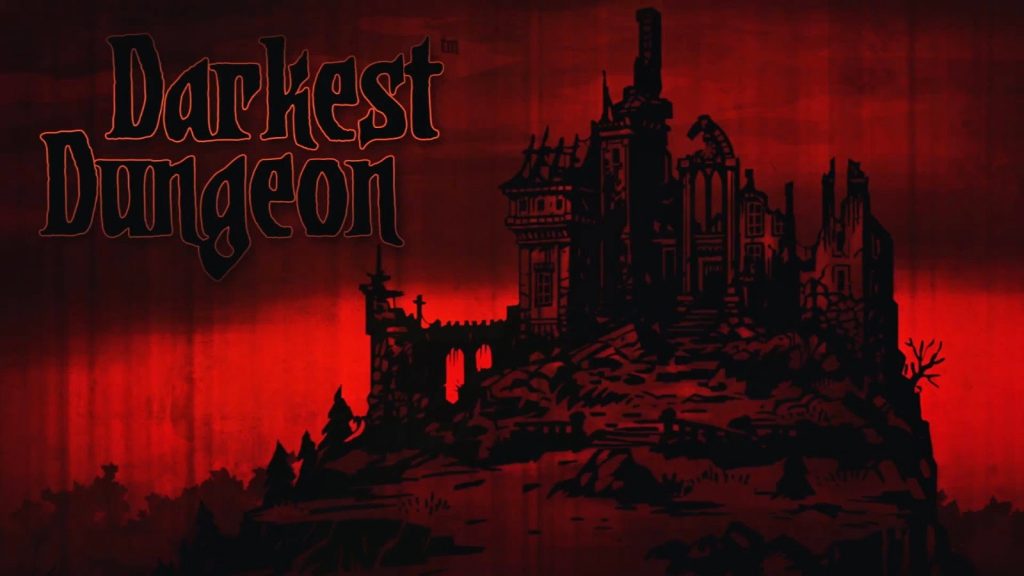Blame Bloodborne.
Although I’ve been a keen reader all of my life, it was only after playing From Software’s incredible action-RPG that I actually read any of author H. P. Lovecraft’s work, the cosmic horror element of Bloodborne – an element brilliantly ommitted from any of the game’s pre-release promotional material – inspiring me to read the entirety of Lovecraft’s fiction writing in the space of a couple of months.
Now a fully-fledged cosmic horror convert, I eagerly picked up Darkest Dungeon, a game which wears its Lovecraft influence with pride, the developer and publisher, Red Hook Studios, even – I assume, anyway – taking its name from Lovecraft’s short story The Horror at Red Hook.
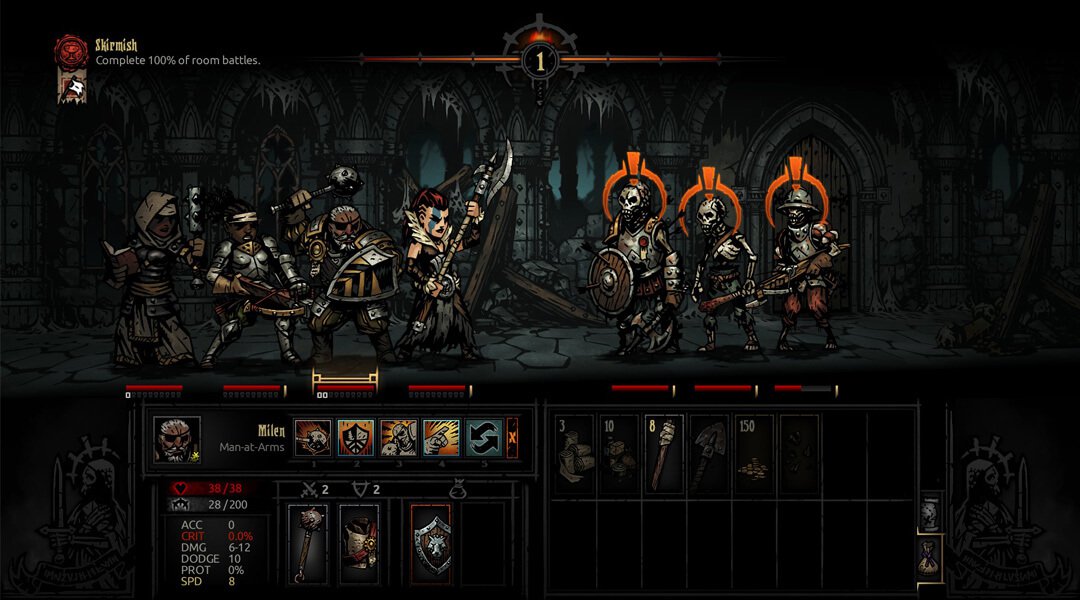
Including both real-time movement and turn-based battles, Darkest Dungeon is a dungeon-crawler in which your goal is to exterminate the malevolent forces which have come to occupy the sprawling estate you have just inherited, this evil having been unleashed due to the actions of your ancestor. (I named my estate the “Carter” estate in honour of Lovecraft’s character Randolph Carter). You do this by recruiting and training adventurers who you form into parties and then send into dungeons to wipe out the creatures within.
Each adventurer – who level-up with successful quests and whose gear can then be upgraded accordingly – fits into one of numerous classes such as crusader, occultist, grave robber, bounty hunter, highwayman, and more unexpected classes such as jester and leper. Each character class also has a number of skills to choose from, so while personally I found some classes to be more useful than others, there’s plenty of room for customisation and for tailoring your squad to suit your own play-style. Still, it’s best not to get too attached to particular characters, as not only does the game auto-save during dungeons but character death is permanent. But more on Darkest Dungeon‘s brutal difficulty later.
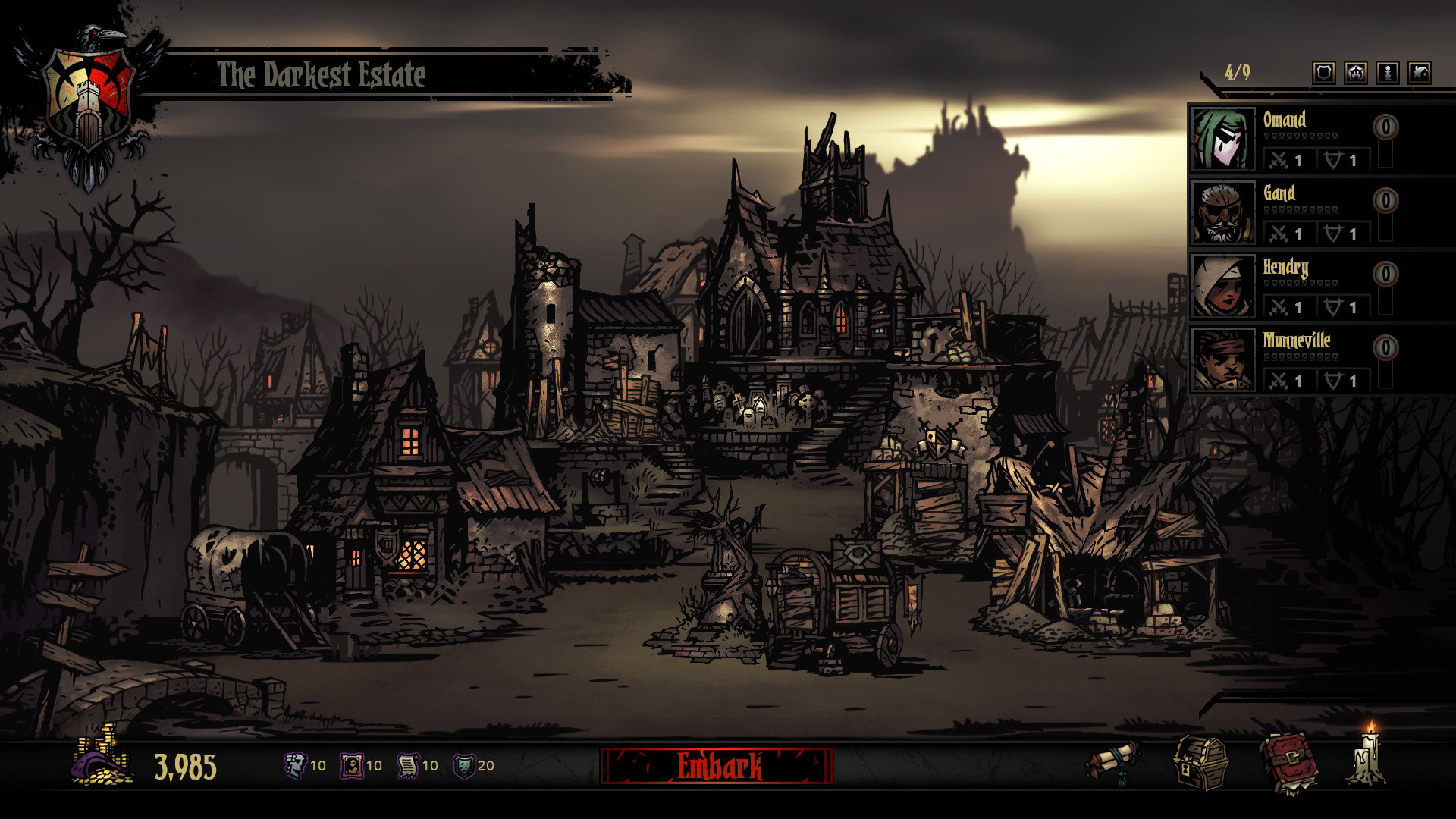
As well as upgrading your heroes, you can also upgrade the hamlet which acts as your hub outside of the game’s dungeons, and this helps to maintain a sense of progression which can feel quashed after failed quests, character deaths, etc. The hamlet’s facilities include a stagecoach at which new adventurers can be recruited, a blacksmith for weapon and armour upgrades, a guild at which you can purchase and upgrade character skills, and several facilities for dealing with the stress and afflictions which your heroes accrue while dungeon-delving.
Yes, a point which Darkest Dungeon constantly emphasises is that descending into terrible dungeons of disease, madness, darkness, death, terrible beasts, and eldritch horrors might not be good for a person’s mental well-being, funnily enough. The more a hero is exposed to such things, the more their stress level increases, and they also develop personality quirks, some positive and some negative. Although these quirks can be removed in the hamlet for a fee, to be honest they were something I came to ignore fairly early on as they’re acquired so frequently that trying to deal with them wasn’t worth the time and money.
Stress is a different matter, however. If a character’s stress level rises too high then they can acquire a particularly detrimental personality trait such as “selfish” or “paranoid”, which affect gameplay by making that character refuse healing, cause additional stress to fellow party members, and more. And if a character’s stress level is allowed to reach its limit then they can even die of a heart attack.
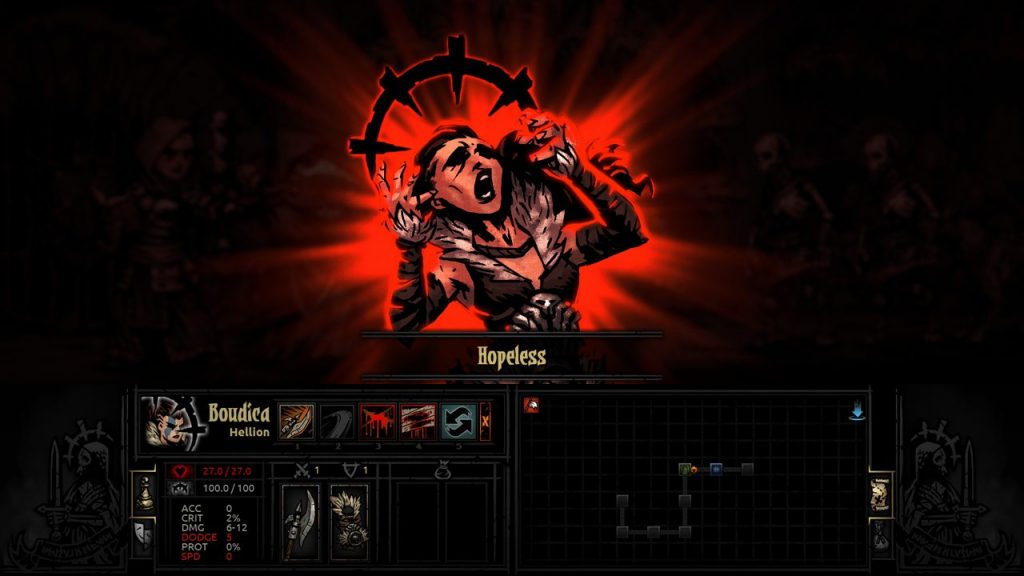
Stress can be lowered in a variety of ways both in dungeons, via particular character skills, and in the hamlet, where you can pay to calm a stressed adventurer by placing them in the tavern, which offers drinking, gambling and prostitutes; or the abbey, which offers meditation, prayer and self-flagellation. (Tavern it is, then). Placing a character in one of these activities makes them unavailable for the following quest, meaning that careful management of your roster of adventurers and upcoming quests is important to making successful progress.
The dungeons themselves – higher-difficulty quests and dungeons being unlocked as you progress – are procedurally generated and each one is made up of a number of rooms and connecting paths, the combat and exploration all taking place on a 2D plane. The dungeons contain numerous enemy encounters, traps and treasures, and some of the higher-difficulty dungeons can take some time to complete, although you can always abandon a quest and have your current party live to fight another day if things are looking too bleak, at the cost of additional stress. If you find yourself engrossed in Darkest Dungeon then you could easily lose dozens or even hundreds of hours to the game.
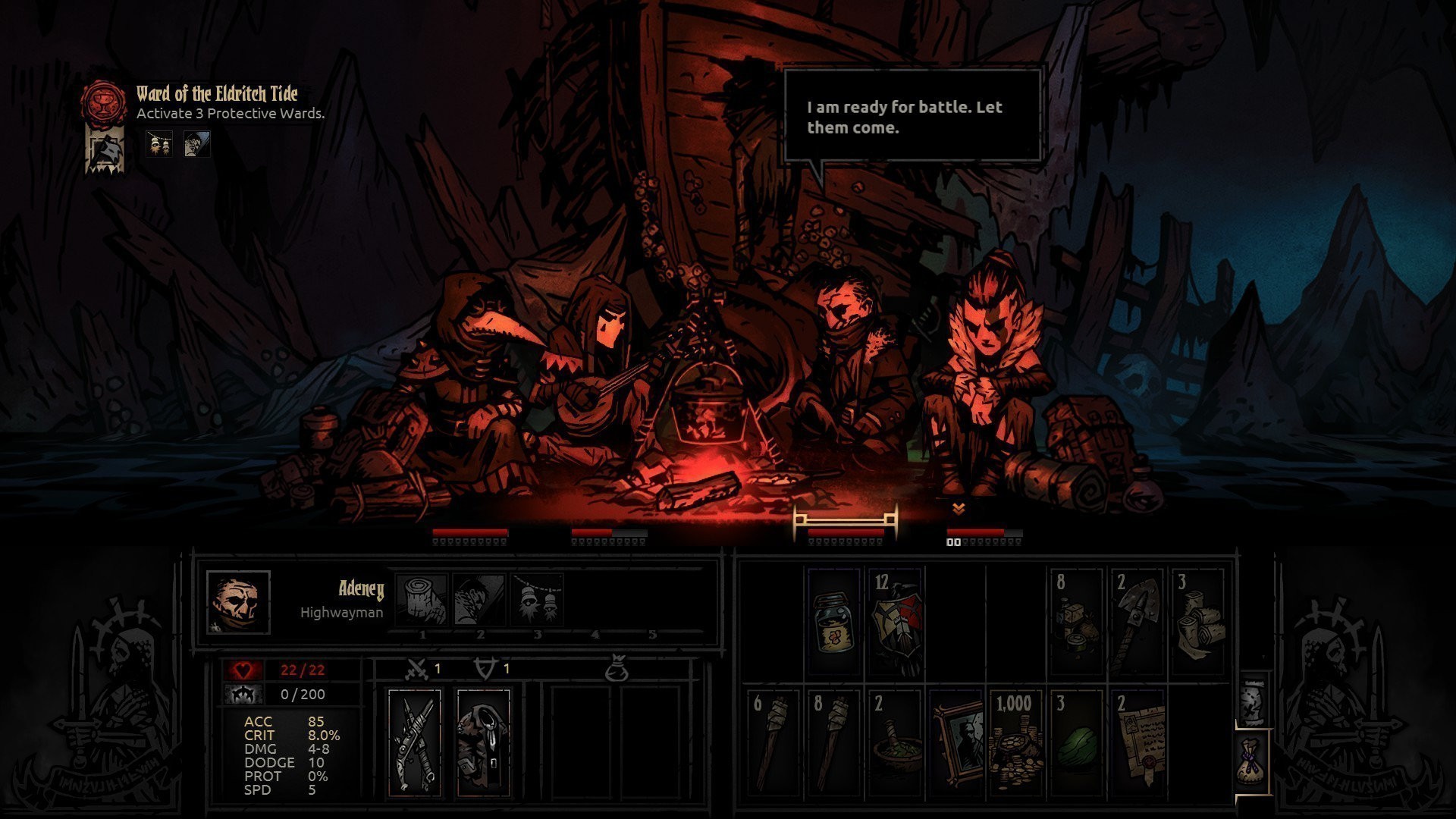
As long as you don’t mind the difficulty, that is. Because Darkest Dungeon doesn’t just like stressing out its characters but also its players: aforementioned elements such as auto-saving, permanent character death, stress levels and negative personality traits are complimented by punishing status affects and enemies and bosses who can easily wipe out your entire party if you’re not careful.
However, while punishing player mistakes is one thing, punishing players via simple luck is another, and can be extremely frustrating if the player feels like the game is screwing them over through no fault of their own. Luck does play a large part in Darkest Dungeon‘s gameplay, and as such there were times early on where I began losing my patience with the game after suffering some setback due to bad luck rather than lack of skill. But although there were times when the difficulty seemed overwhelming and I was sure that my current party of adventurers were all about to be murdered, I usually ended up surviving the encounters in question and completing the quest, even if only by the skin of my teeth. It made me realise that although Darkest Dungeon sometimes places you in a situation which may seem insurmountable, it’s important to keep fighting and pressing forward towards your goal.
(*Note: the author accepts no responsibility if keeping fighting and pressing forward towards your goal gets your entire party butchered by some horrific abomination).
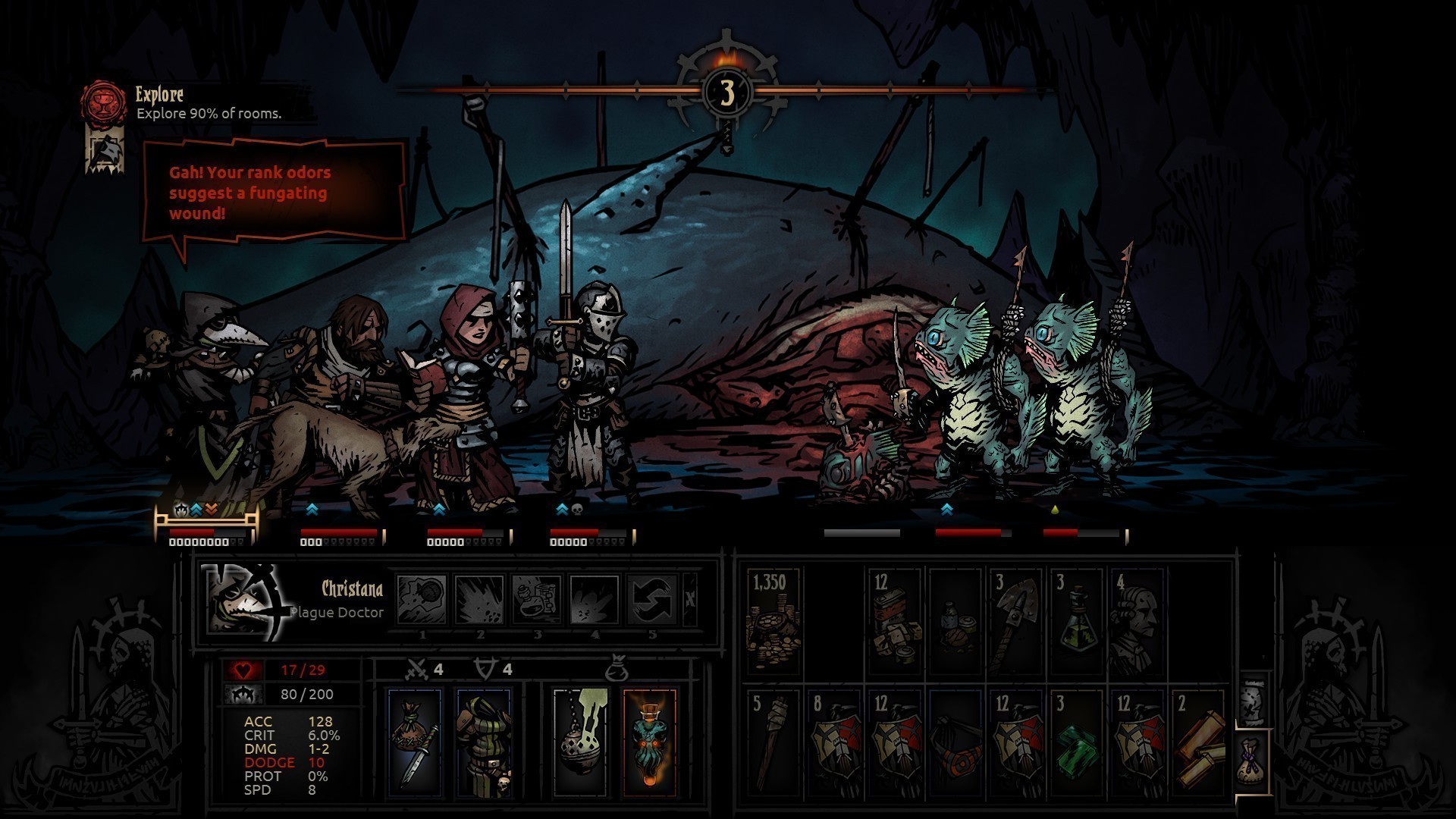
As much as I enjoy the gameplay of Darkest Dungeon, and although gameplay is king when it comes to videogames as far as I’m concerned, I’d be lying if I said that the game’s presentation isn’t perhaps my favourite aspect of it. The sound is brilliant, featuring a suitably dark and menacing soundtrack alongside fantastically written and excellently performed narration from the gravel-voiced Wayne June, a voice actor who has previously recorded readings of some H. P. Lovecraft stories.
Then there’s the hand-drawn artwork by Chris Bourassa, who also serves as the game’s director. Bourassa’s shadowy and hard-edged style – one which reminds me of Hellboy creator Mike Mignola’s art in particular – like the sound design, does its job perfectly in helping to create an atmosphere of bleakness and dread.
Finally, it’s nice to know that there’s more wonderful suffering to come, as Red Hook Studios have announced plans to release two new game modes in a free update, as well as a paid expansion.
While Darkest Dungeon certainly isn’t a game for everyone, it’s an excellent dungeon-crawler which I wouldn’t hesitate to recommend to anyone prepared to brave its terrible depths and face the eldritch nightmares and monstrous secrets within. Just remember, as Lovecraft himself wrote, “The oldest and strongest emotion of mankind is fear, and the oldest and strongest kind of fear is fear of the unknown.”
You should probably be wary of giant, malformed, humanoid pig-beasts with massive meat-cleavers as well, though. Just saying.
Emily Medlock is an avid gamer whose passions not only include video games of all kinds, but anime, music, movies, and reading.

